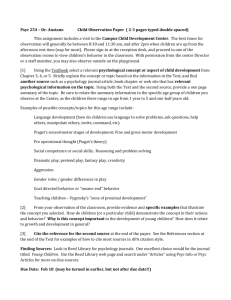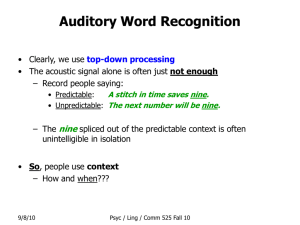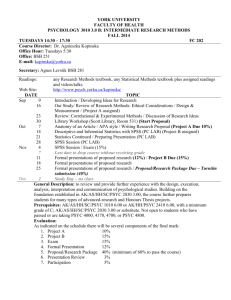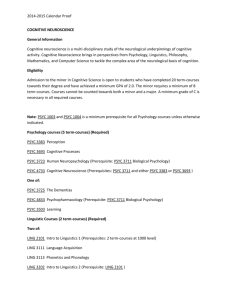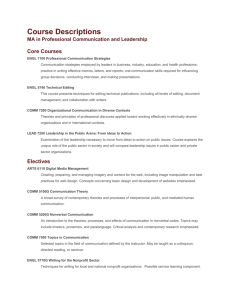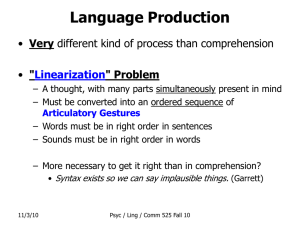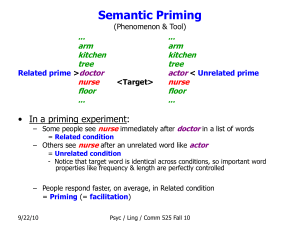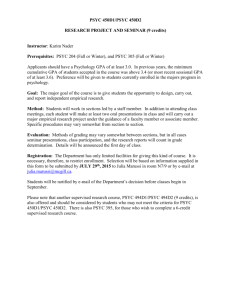Sentence Comprehension Lecture 100610
advertisement
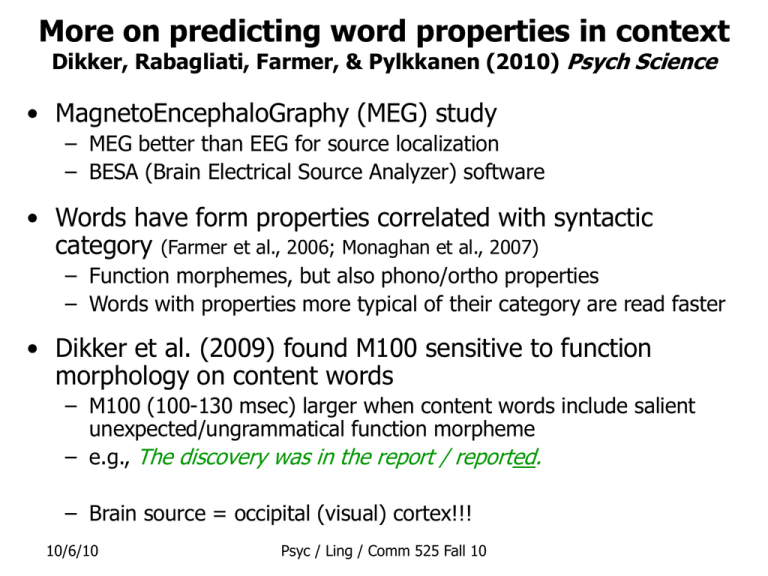
More on predicting word properties in context Dikker, Rabagliati, Farmer, & Pylkkanen (2010) Psych Science • MagnetoEncephaloGraphy (MEG) study – MEG better than EEG for source localization – BESA (Brain Electrical Source Analyzer) software • Words have form properties correlated with syntactic category (Farmer et al., 2006; Monaghan et al., 2007) – Function morphemes, but also phono/ortho properties – Words with properties more typical of their category are read faster • Dikker et al. (2009) found M100 sensitive to function morphology on content words – M100 (100-130 msec) larger when content words include salient unexpected/ungrammatical function morpheme – e.g., The discovery was in the report / reported. – Brain source = occipital (visual) cortex!!! 10/6/10 Psyc / Ling / Comm 525 Fall 10 Dikker, et al (2010) cont’d Is salient category-typical morphology required? Example Stimuli - Nouns w/ derivational noun morph: princess, farmer - Nouns w/ non-morph-marked but typical form: soda - Nouns w/o form-correlated properties: infant - (Form typicality derived from large corpus analysis by Farmer et al., 2006 and Monaghan et al., 2007) Presented in context that predicts: - Noun: The tasteless soda … - Participle: The tastelessly soda … 10/6/10 Psyc / Ling / Comm 525 Fall 10 In participle-predicting contexts: M100 bigger for morphologically marked nouns - Replicates Dikker et al. (2009) M100 also bigger for nouns with more noun-like phonology/orthography - So, salient function morphology not necessary No M100 difference for neutral nouns - Also replicates Dikker et al. (2009) 10/6/10 Psyc / Ling / Comm 525 Fall 10 Probabilistic Word Prediction The more the form properties of a word are typical for its syntactic category, the bigger the M100 in a context that predicts a word from a different category - By 100-130 msec (!) in visual regions sensitive to letter/non-letter distinctions (!) - Dikker argues it’s visual word form properties that don’t match prediction, NOT syntactic category per se 10/6/10 Psyc / Ling / Comm 525 Fall 10 Issues in Sentence Comprehension • Parallel vs Serial – Parallel = Construct multiple interpretations & wait for evidence about which is right – Serial = Construct only 1 interpretation at first, & then try another only if that turns out to be wrong (two stages) • Which makes more sense depends on whether easier to – Construct multiple interpretations & hold onto them long enough to avoid making a mistake – Or construct just one interpretation & hope it’s right – If first choice usually right, serial approach could be more efficient 10/6/10 Psyc / Ling / Comm 525 Fall 10 • Modular vs Interactive – Modular = Take only syntactic properties of words (N, V, Prep, etc.) & phrase structure options into account at first – Interactive = Take word meaning, context, & general knowledge into account all along • Again, which makes more sense depends on whether it’s easier to – Make quick first guesses based on just syntactic categories of words & some basic phrase structure patterns – Or combine syntax, meaning, context, & knowledge fast enough in first place 10/6/10 Psyc / Ling / Comm 525 Fall 10 Garden Path Model (Frazier, Rayner, Clifton, F. Ferreira) • Influential serial (two-stage) modular parsing model – Name comes from claim that we frequently gardenpath during comprehension • But only become aware of it occasionally • Minimal Attachment Strategy – Whenever multiple structural options, start with simplest one • i.e. one requiring adding fewest nodes to phrase structure tree at that point in sentence 10/6/10 Psyc / Ling / Comm 525 Fall 10 Structural Ambiguity Attachment ambiguity S S Nonminimal VP Minimal VP NP NP V NP PP A thief shot the cop in the park. 10/6/10 NP V NP PP A thief shot the cop in the park. Psyc / Ling / Comm 525 Fall 10 Prediction of GP Model • All sentences with Nonminimal Attachment (NMA) structures should be harder than all sentences with Minimal Attachment (MA) structures – Because always have to revise a wrong first guess in NMA sentences – That should take some time • Though often not enough to become aware of problem 10/6/10 Psyc / Ling / Comm 525 Fall 10 Rayner, Carlson, & Frazier (1983) • Measured how long people spent reading different regions of sentences using an eyetracker • Stimuli: – Minimally Attached: The doctor examined the patient with the stethoscope, but he couldn’t figure out what was wrong. – Non-minimally Attached: The doctor examined the patient with the headache, but he couldn’t figure out what was wrong. • Prediction of GP Model: – People should read headache & the words after it more slowly than stethoscope & the words after it 10/6/10 Psyc / Ling / Comm 525 Fall 10 Results – First Pass Times 10/6/10 Psyc / Ling / Comm 525 Fall 10 Interpretation • Results support GP Model – Slower reading times after headache suggest people garden-pathed & had to reinterpret • But, do Rayner et al.’s stimuli provide fair test of MA Strategy? – Temporary ambiguity starts at with – Is there anything earlier in sentence that might bias interpretation one way or other? – The verb examined, maybe? • Does it lead to expectations for certain kinds of phrases following it? (Bresnan) 10/6/10 Psyc / Ling / Comm 525 Fall 10 Verb Argument Structure • Verbs are the most important words in sentences (in English) – All other words are interpreted relative to the verb – The librarian put the book on the shelf. • put requires all 3 of these arguments to be in the sentence, • i.e. all 3 arguments are obligatory • Subject / Agent = librarian • Object / Patient (Theme) = book • Location = shelf * The librarian put. * The librarian put the book. • The librarian put on the shelf. • Most verbs have some optional arguments – The doctor examined the patient. – The doctor examined the patient with a stethoscope. – * The doctor examined. 10/6/10 Psyc / Ling / Comm 525 Fall 10 Verb Bias • Verbs differ in how often they are used with their optional arguments – examine is probably often used with an optional Instrument • Maybe Rayner et al. happened to use lots of verbs that often take the kinds of arguments that were present in MA versions? – Would bias results in favor of MA sentences 10/6/10 Psyc / Ling / Comm 525 Fall 10 Taraban & McClelland (1988) • Measured reading times using self-paced moving window technique • Stimuli: – Used Rayner et al.’s materials – Plus just as many more like: MA: John read the article in the bathtub while he was waiting for a call. NMA: John read the article in the magazine while he was waiting for a call. • Where John read the article in the ... seems to lead to expectation of – something modifying article (= NMA) rather than a location where the reading event took place (= MA) 10/6/10 Psyc / Ling / Comm 525 Fall 10 Results 10/6/10 Psyc / Ling / Comm 525 Fall 10 Taraban & McClelland’s Conclusions • No general Minimal Attachment Strategy • People use knowledge about particular words & how they’re most likely to be used to guide their interpretation – Especially verbs? • Serial vs Parallel – Supports serial model – should be no GP if fully parallel • Modular/Interactive – If verb bias is syntactic, results have no consequence – If word meaning or extra-sentential context had an immediate effect, that would clearly support Interactive 10/6/10 Psyc / Ling / Comm 525 Fall 10 Another Kind of Temporary Structural Ambiguity “Marge Schott, managing partner of the Cincinnati Reds, at first did not want to apologize for her remark that Hitler‘was good at the beginning but he just went too far’. Under pressure, she finally said that she regretted her remarks ‘offended many people’.” - NY Times, 7/21/96, D. Tannen, I’m sorry, I won’t apologize 10/6/10 Psyc / Ling / Comm 525 Fall 10 that The referees warned the spectators against heckling the other team. would probably get too rowdy. ^ Temporary ambiguity about relationship between the Verb & the Noun after it - Is the noun a - Direct Object (DO) (= Minimal Attachment), or - Subject of an Embedded Clause (= NMA)? - Ambiguity arises because that is optional (in English – obligatory in German, Dutch) 10/6/10 Psyc / Ling / Comm 525 Fall 10 Verb Bias • Verbs differ in how often they’re used in particular sentence structures – Compare The referees warned the spectators ... with The bus driver worried the passengers ... warned = Direct-Object Biased Verb worried = Clause-Biased Verb Does a verb's most likely use guide initial choices about the interpretation of words following it? 10/6/10 Psyc / Ling / Comm 525 Fall 10 Plausibility of Noun as Direct Object • Plausibility of particular Verb + Noun combos in particular relationships vary – Compare The referees warned the spectators ... with The referees warned the game ... – Meaning of game completely rules out DO possibility • Does that lead people to expect a verb following game because it must be the beginning of an embedded clause? • If yes, how long does it take to develop that expectation? 10/6/10 Psyc / Ling / Comm 525 Fall 10 Example Stimuli (Garnsey et al., 1997) DO-Bias Verbs (warned, discovered, heard, …) The referees warned (that) the spectators would probably get too rowdy. The referees warned (that) the game would probably go into overtime. Clause-Bias Verbs (worried, realized, suspected, …) The bus driver worried (that) the passengers were starting to get annoyed. The bus driver worried (that) the tires were starting to go flat. Equi-Bias Verbs (regretted, predicted, knew, …) The senior senator regretted (that) the decision had ever been made public. The senior senator regretted (that) the reporter had ever seen the report. 10/6/10 Psyc / Ling / Comm 525 Fall 10 Stimulus Norming & Control Verb Properties Verb Type Freq Length DO-Bias Cl-Bias that-Pref DO-Bias 146 8.3 14% 75% 89% Equi-Bias 178 7.6 36% 38% 71% Clause-Bias 128 7.7 79% 12% 67% Ambiguous Noun Properties Plausible as DO Implausible as DO Freq Len DO Rate Cl Rate Freq Len DO Rate Cl Rate DO-Bias 132 6.3 6.5 5.7 166 5.5 2.9 5.4 Equi-Bias 106 6.5 6.7 5.9 62 6.3 2.9 5.7 Clause-Bias 67 6.7 6.9 6.3 47 6.3 2.6 6.1 Verb Type 10/6/10 Psyc / Ling / Comm 525 Fall 10 Reading Time Results (Same pattern in button-pushing moving window & eyetracking first pass) DO-Bias Verbs The referees warned the spectators would probably get too rowdy. The referees warned the game would probably go into overtime. read slowly Clause-Bias Verbs The bus driver worried the passengers were starting to get annoyed. The bus driver worried the tires were starting to go flat. read slowly Equi-Bias Verbs The senior senator regretted the decision had ever been made public. The senior senator regretted the reporter had ever seen the report. 10/6/10 Psyc / Ling / Comm 525 Fall 10 Verbs Rule • No immediate effect of Plausibility of V + N combination when V had a strong bias • But Plausibility did have an immediate effect when no V-bias • So, the two factors interact, with Verb Bias dominating the interaction • Consistent with Constraint-Satisfaction Models, with some kinds of constraints being more influential 10/6/10 Psyc / Ling / Comm 525 Fall 10 Event-Related Brain Potentials (ERPs) & Language • N400 (Plausibility, Contextual fit) – Negative, 400 msec – Centro-parietal maximum, sometimes larger on right • P600 (Garden-paths, grammar errors, complexity,…) – Positive, >500 msec – Centro-parietal maximum 10/6/10 Psyc / Ling / Comm 525 Fall 10 Stimulus Presentation in ERP Study Were the referees expecting overtime. probably referees warned would game The into the go 1 a long game? READY QUESTION 10/6/10 Psyc / Ling / Comm 525 Fall 10 Waveforms Starting at Temporarily Ambiguous Noun Pz DO-Bias Verbs (warned) Final word -6 Plausible Noun: The referees warned the spectators ... -3 0 3 6 0 650 1300 1950 2600 Msec spectators 10/6/10 Psyc / Ling / Comm 525 Fall 10 Question Waveforms Starting at Temporarily Ambiguous Noun N400 Pz DO-Bias Verbs (warned) -6 Plausible Noun: The referees warned the spectators ... Implausible Noun The referees warned the game ... -3 0 3 6 0 650 1300 Msec spectators/ game 10/6/10 Psyc / Ling / Comm 525 Fall 10 1950 2600 Waveforms Starting at Temporarily Ambiguous Noun DO-Bias Verbs (warned) Plausible Noun: The referees warned the spectators ... Implausible Noun The referees warned the game ... N400 Pz -6 -3 0 3 6 0 650 1300 1950 2600 1950 2600 Msec spectators/ game Clause-Bias Verbs (worried) -6 -3 Plausible Noun: The bus driver worried the passengers ... 0 3 Implausible Noun: 6 The bus driver worried the tires ... 0 650 1300 Msec passengers/ tires 10/6/10 Psyc / Ling / Comm 525 Fall 10 Waveforms Starting at Temporarily Ambiguous Noun DO-Bias Verbs (warned) Plausible Noun: The referees warned the spectators ... Implausible Noun The referees warned the game ... N400 Pz -6 -3 0 3 6 0 650 1300 1950 2600 1950 2600 Msec spectators/ P600 game Clause-Bias Verbs (worried) -6 -3 Plausible Noun: The bus driver worried the passengers ... 0 3 Implausible Noun: 6 The bus driver worried the tires ... 0 650 1300 Msec passengers/ tires 10/6/10 Psyc / Ling / Comm 525 Fall 10 Verbs still rule. Why? • Principled reasons: – They provide the most useful information – Information about them may be simply retrieved, while plausibility requires combining information from multiple words • More accidental reasons: – They precede the critical nouns in these sentences [ but, see Trueswell (1996) ] – They generally appear early in English sentences, leading English speakers to rely on them 10/6/10 Psyc / Ling / Comm 525 Fall 10 Back to Usual Issues • Effect of plausibility supports Interactive ConstraintSatisfaction Models • With some kinds of info outweighing &/or available earlier than others • Any evidence about Serial vs Parallel? • Reliable correlations between RT at disambiguation & strength of bias toward less preferred structure when plausibility supported the less-preferred structure • Clause-bias V + Plausible-as-DO N: - Difficulty increased as DO-bias strength of V increased (r = +.53) • DO-bias V + Implausible-as-DO N: - Difficulty decreased as Cl-bias strength of V increased (r = -.58) • Strongly suggests weighing both options = parallelism 10/6/10 Psyc / Ling / Comm 525 Fall 10 GP Modelers’ Response • Studies show various factors make easier the structures predicted by GP Model to be hard – So, all of these effects COULD be during 2nd stage reanalysis, since should only try harder option when forced to reanalyze • To be definitive, need to show that same factors can make harder the structures predicted by GP Model to be easier – Then effects can’t be due to reanalysis, since no reanalysis should be necessary according to GP Model 10/6/10 Psyc / Ling / Comm 525 Fall 10 Wilson & Garnsey (2009) • Are sentences with DO structures made harder by having a Clause-bias verb? • Sentences with either Clause or DO structures DO-bias V The ticket agent admitted the mistake might not have been caught. The ticket agent admitted the mistake because she had been caught. Clause-bias V The CIA director confirmed the rumor could mean a security leak. The CIA director confirmed the rumor when he testified to Congress. 10/6/10 Psyc / Ling / Comm 525 Fall 10 Moving Window RT Results at disambiguating region 80 a C Clause with "that" B Clause without "that" 60 J Sentence with DO B Sentence with Clause B B 40 J B B 20 b C C Clause-bias DO-bias J 0 Clause-bias Verb Bias 10/6/10 Psyc / Ling / Comm 525 Fall 10 DO-bias Verb Bias Eyetracking First Pass Times at disambiguating region 50 a C Clause with "that" B Clause without "that" b J Sentence with DO B Sentence with Clause 25 B B 0 -25 B B J C C J -50 Clause-bias DO-bias Clause-bias Verb Bias 10/6/10 Psyc / Ling / Comm 525 Fall 10 DO-bias Verb Bias Regression-Path Times at disambiguating region (also called Right-Bounded or Go-Past Times) 100 B 75 50 J 25 0 J Sentence with DO B Sentence with Clause B Time from when: J -25 -50 Clause-bias DO-bias Verb Bias 10/6/10 - First enter a region - Until leave that region with forward-going saccade -Includes time regressing back to previous regions Psyc / Ling / Comm 525 Fall 10 Back to Usual Issues • So, evidence supports both Parallelism & Interaction of multiple within-sentence constraints • And shows Verb Bias effects in sentences that should not require any reanalysis according to GP – But Verb Bias effects could be part of 1st stage, since may be a kind of syntactic knowledge – And N+V plausibility effects are only testable in sentences with Clause structure, so could be due to reanalysis • What about constraints from outside sentence? 10/6/10 Psyc / Ling / Comm 525 Fall 10 The Role of Prosody • Embedded Clause / Direct Object sentences can be disambiguated with prosodic phrasing • Acoustic correlates: – – – – – 10/6/10 Pause Pre-boundary lengthening Pitch contour Pitch reset … Psyc / Ling / Comm 525 Fall 10 How does this kind of prosodic boundary marking influence sentence interpretation? • Example of DO Prosody – The basketball star accepted the contract… …because it paid so well. Example of Clause Prosody - The basketball star accepted … … the contract required him to play every game. 10/6/10 Psyc / Ling / Comm 525 Fall 10 Do speakers produce different prosody in DO and Clause structures? Gahl & Garnsey (2004) 10/6/10 Psyc / Ling / Comm 525 Fall 10 Boundaries marked more strongly when Structure not consistent with Verb Bias 10/6/10 Psyc / Ling / Comm 525 Fall 10
